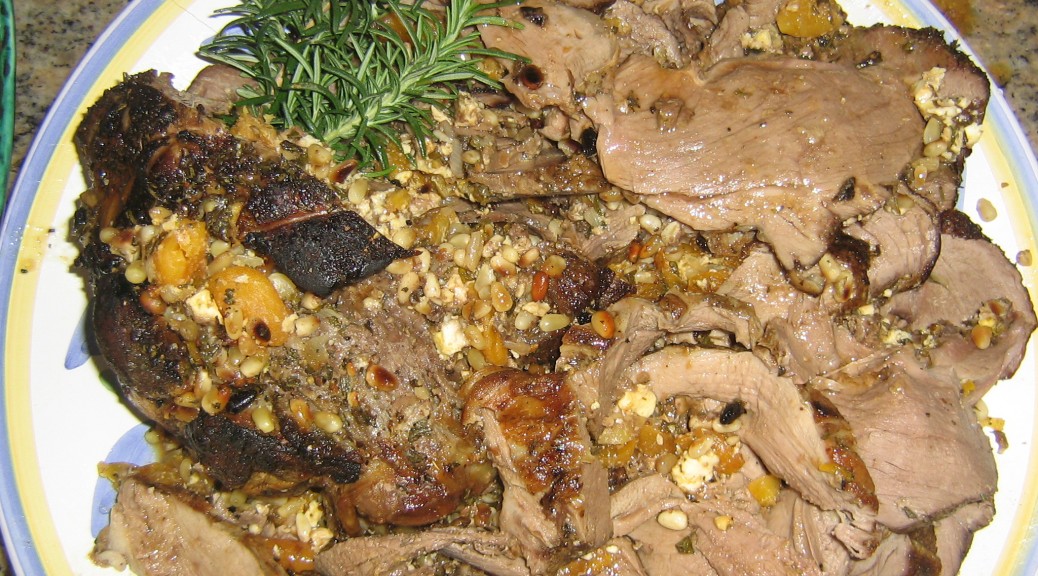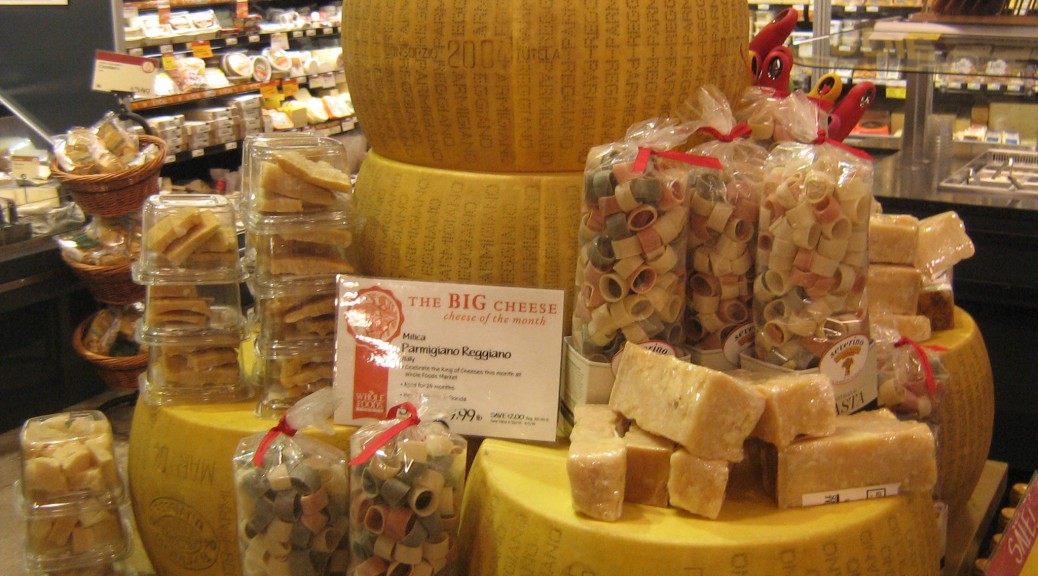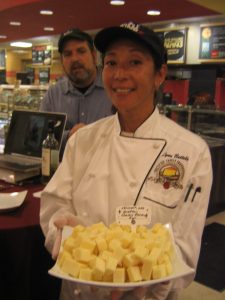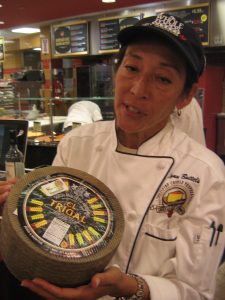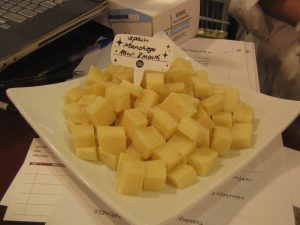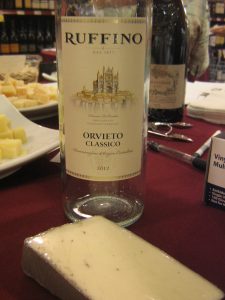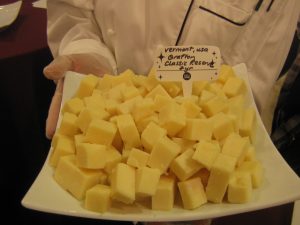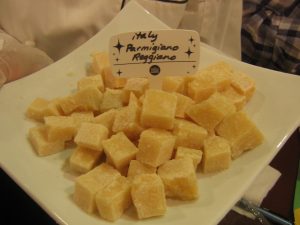“Dining with one’s friends and beloved family is certainly one of life’s primal and most innocent delights, one that is both soul-satisfying and eternal.” Julia Childs
The convergence of Spring, Easter, family and friends resulted in one really spectacular meal. This past weekend we celebrated Easter with tender grass-fed Colorado leg of lamb, cheesy potatoes dauphinoise, asparagus with lemony butter, puree of carrot – light as a feather and spiked with cream, and that quintessential dessert, strawberry tart, with sweet pastry cream that melts on the tongue , and heavenly strawberries spiked with orange liquor adding a surprisingly peppy note that balanced the richness of the cream.

It was finally time to taste that leg of lamb which had been roasting in rosemary and garlic with its heady aromas for over an hour. At the table we relished the sight of all the colorful dishes. I had been looking forward to this meal and the company of friends and family all week. Both elegant and colorful with flavors that pop ….. this meal is a memory maker!
Ingredients
|
|
- Place 3 carrots in a pot. Cover with water and add 2 teaspoons salt. Bring to a boil and simmer for 20 minutes. Carrots should be tender to the point of a knife.
- Drain.
- Line a bowl with cheese cloth.Place carrots in a food mill and strain on top of the cheesecloth.
- Tie the corners of the cheesecloth. Push a stick through it and let it hang in a deep vessel to drain the pulp of excess moisture for 2 hours.Lift and press to extrude more liquid. Use the liquid for vegetable stock in soup. Place the pulp in a saucepan. Add heavy cream, butter, salt, and pepper to taste. Heat slowly on low heat and serve hot.
Prepare a day in advance. © Galley Chef All Rights Reserved
I tried to find a local butcher that had grass-fed lamb but that was like trying to whip cream with a toothpick. I ended up ordering the lamb on-line from an organic Colorado farmer. For the best looking presentation, I trimmed about an inch of flesh from the shank bone. The fell is a thin outer layer of fat that you find if you buy an untrimmed leg from a butcher. It’s very tough so it’s important to remove all of it. Trim the excess fat that lies beneath the fell as well, leaving enough to enrich the meat and gravy.
| Prep Time | 25 minutes |
| Servings |
|
- 1 cup dried apricots chopped
- 2 T Shallots minced
- 1 T butter
- salt and pepper to taste
- 1 1/2 cups feta cheese crumbled
- 1 cup pine nuts toasted
- 1/2 cup mint
- 5 pounds leg of lamb butterflied
- 1 T olive oil
Ingredients
|
|
- Preheat oven to 375 degrees F. Cut six 2-foot lengths of butcher's twine. In a small skillet sauté apricots and shallots in butter 1 minute or until lightly browned. Transfer to a small bowl and mix well with feta cheese, pine nuts and mint; season to taste with salt and pepper.
- To butterfly the lamb. Arrange the lamb on work surface, inside facing up. Cut through to the bone. Then around the bone on each side to open it up.
- Place a sheet of plastic wrap over lamb and pound with a meat mallet to flatten meat slightly, if needed, until leg is a fairly even thickness. Remove plastic wrap and generously season inside and outside of lamb with salt and pepper.
- Mound stuffing mixture lengthwise along one side of lamb; roll up lamb over stuffing, tucking in ends.
- Space 5 pieces of twine under lamb roll and tie them firmly, starting at outside and working in. Tie roll lengthwise with remaining piece of twine. In a roasting pan set over 2 burners, heat oil over high heat. Add lamb roll and sear all over, about 6 minutes in all. Transfer lamb to a rack and set down in the roasting pan. Roast until brown and tender and an instant read thermometer reads 140 degrees F for medium rare, about 1 hour to 1 hour and 15 minutes, basting occasionally. Remove from oven and let sit, covered loosely with foil, 10 minutes. To serve, discard strings, slice in 12 pieces and serve
© Galley Chef All Rights Reserved
I purchased two legs so, with any luck, I would have leftovers to make shepherds pie.
| Cook Time | 1 hour |
| Passive Time | 12 hours |
| Servings |
|
- 4 pounds russet potatoesthinly sliced on a mandolin
- 4 cloves Garlicminced
- 5 cups milk
- 4 cups heavy cream
- 8 ounces Gruyere cheeseshredded
- 1/2 teaspoon fresh nutmeggrated
- salt and pepperto taste
Ingredients
|
|
- Finely slice the potatoes using a mandoline and set aside in water until ready to use. Combine the cream, milk, nutmeg, garlic and a pinch of salt and pepper in a large saucepan and bring to the boil. Once boiling, remove from the heat and set aside. Strain the water off the potatoes and layer inside a small oven dish lined with parchment paper, sprinkling gruyere cheese between each layer and being sure to overlap each layer as you go. Preheat the oven to 350 degrees. Pour enough of the cream mixture over the potatoes to cover and bake in the oven for 45 minutes or until slightly golden on top and tender through the middle. Remove from the oven and allow to cool. Weigh down with butter, cheese or any other heavy square object and set aside in the fridge to press for up to 12 hours. Reheat the potato dauphinoise in the oven set to 350 degrees for 15 minutes. Divide into portions and serve immediately as a side dish.
* Make this a day in advance and reheat for your party. For a variation, layer with cooked mushrooms and truffle cheese. © Galley Chef All Rights Reserved
The potatoes dauphinoise are classic. They need to “rest” for 12 hours while under a press, so they make a great “do ahead” party dish. In the unlikely event that there are leftover potatoes, heat up a stack for breakfast with a poached egg on top.
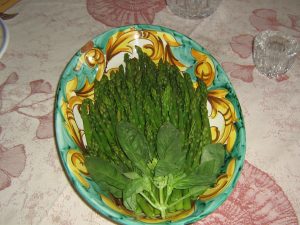
Check out the beautiful spring-like feel to this dish of asparagus. Line up cooked asparagus spears and drizzle with lemony butter (lemon zest and butter) for an unforgettable presentation. Serve warm or at room temperature.
| Servings |
|
- 1 1/2 Cups flour
- 4 T sugar
- 1 tsp salt
- 1 stick butter plus 2 Tablespoons ice cold and diced
- 1/4 cup ice water
- 2 Cups pastry cream recipe follows
- 2 pints strawberries cleaned and halved
- 1/2 cup apricot jelly
- 2 T orange liquor
- 5 large egg yolks room temperature
- 3/4 cup sugar
- 3 T cornstarch
- 1 1/2 cup milk scalded
- 1/2 teaspoon vanilla extract
- 1 teaspoon orange liquor
- 1 T butter
- 1 T heavy cream
- 1 T heavy cream
Ingredients
For the Tart
For the pastry cream
|
|
- Combine the flour, sugar, and salt in a small bowl and place in the freezer for 30 minutes. Put the flour mixture in the bowl of a food processor fitted with a steel blade. Add the butter and shortening and pulse about 10 times, or until the butter is in the size of peas. Add the ice water and process until the dough comes together. Dump on a well-floured board and form into a disk. Wrap in plastic and chill for at least 30 minutes. Meanwhile, preheat the oven to 375 degrees F. Roll out the dough and fit into 4 (4 1/2-inch) tart pans with removable sides. Don't stretch the dough when placing it in the pans or it will shrink during baking. Cut off the excess by rolling the pin across the top of each pan. Line the tart shells with a piece of buttered aluminum foil, butter side down, and fill them with dried beans or rice. Bake for 10 minutes. Remove the beans and foil, prick the bottom of the shells all over with a fork, and bake for another 15 to 20 minutes until lightly browned. Set aside to cool.
- Before serving, fill the tart shells with the pastry cream. Arrange the berries decoratively on top of the cream. Melt the apricot jelly with 1 teaspoon of water and brush the top of the tarts. Sprinkle with pistachios, if using, and serve.
- In the bowl of an electric mixer fitted with the paddle attachment, beat the egg yolks and sugar on medium-high speed for 4 minutes, or until very thick. Reduce to low speed, and add the cornstarch. With the mixer still on low, slowly pour the hot milk into the egg mixture. Pour the mixture into a medium saucepan and cook over low heat, stirring constantly with a wooden spoon, until the mixture thickens, 5 to 7 minutes. Don't be alarmed when the custard comes to a boil and appears to curdle; switch to a whisk and beat vigorously. Cook, whisking constantly, for another 2 minutes; the custard will come together and become very thick, like pudding. Stir in the vanilla, orange liquor, butter, and heavy cream. Pour the custard through a sieve into a bowl. Place plastic wrap directly on the custard and refrigerate until cold. Yield: 2 cups
© Galley Chef All Rights Reserved
I didn’t think I would have room for the Strawberry Tart, but I managed to squeeze it in!
Happy Spring! Happy Easter!
